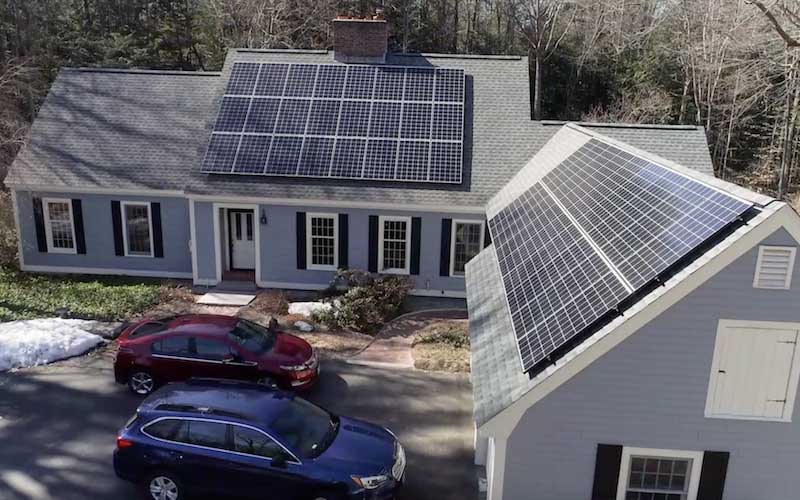
Melissa's energy bills dropped after installing solar panels on her home in central New Hampshire. Photo Credit: Ecophotography for CLF
When Melissa Birchard and her family first moved into their home in central New Hampshire, they were excited. The wooded neighborhood offered plenty of outdoor space for her young twins to play and boasted a nearby pond where they could skate in the winter.
But Melissa soon discovered a downside to her new home. “Our heat and electricity bills were super high,” she says, and keeping the family comfortable was more expensive than she and her husband had expected.
As an attorney for CLF at the time, Melissa already knew that energy efficiency measures like LED lightbulbs and clean, home-grown energy like solar could help. And since New Hampshire relies on dirty fossil fuels like oil, coal, and gas for heat and electricity, cutting her bills would also mean making her home cleaner and safer for her kids, including one child with asthma.
So Melissa began the process of transforming her home into one that would help her to not only drop her energy bills, but also do her family’s part to help New Hampshire kick its addiction to dirty fossil fuels.
Bringing Down Her Energy Bills
Living in New England – with its increasingly hot summers and below-freezing winters – Melissa first wanted to make sure that she wasn’t actively wasting energy. So she and her husband switched their lightbulbs to LEDs, plugged any holes where heat could slip out, and updated old appliances. (To learn more about how they have updated their house into a cleaner home, stay tuned for an upcoming blog.)
Those simple changes made a difference, but Melissa knew she wanted to do more. So she decided to look at how her family powered their home.
She’d been interested in getting solar panels even before they bought the house, and had reached out to a local solar company back when she was working with her real estate agent. “I sent someone at the company the Google link to houses I was looking at buying and asked if they were okay for solar panels or heat pumps,” she said. “These companies will often help you no matter where you are in the process.”
Now that they had moved in and were ready to think more seriously about installing solar panels, Melissa dove deeper into research mode. How much was it going to cost? What benefits were available from the state and federal governments? How many solar panels should she get? Should she buy or lease them?
Working with an Installation Company
As with any home construction project, Melissa suggests taking the time to talk to a few different companies. Through talking with her own local installation company, Melissa confirmed that rebates and tax credits are available for solar panels – both of which make a big difference in the overall costs.
The costs to install the panels was another consideration. Melissa’s yard has a number of tall oak trees that help make her home feel pleasant and private, but she worried they would block some of the light from hitting her roof. So she continued to ask questions.
“The company came out and took a look at our roof and our electrical panel,” she explains. “Then they looked at past electricity bills so they could determine how much solar our house needed.” They also looked at other factors that could make a difference in the cost and size of the array for their home: Do the trees nearby matter? Where does the snow collect? Are you planning for an electric car?
With this information in hand, the company then developed estimates based on different scenarios: a small array of solar panels, which would offset some of her energy costs, and a much larger array, which would entirely cover her electricity bills and then some.
Melissa chose a number in the middle, and then submitted her state rebate application with the help of her solar company. Soon installation began. After a few weeks, Melissa’s solar panels were up and running.
Life with Solar Panels
The benefits have been tangible, says Melissa. With panels across the roof of their house, Melissa’s family now has a surplus of electricity most of the year. Through net metering, a state program that allows solar panel owners to get compensated for any extra power they produce and send back to the electric grid, this surplus results in bill credits she can use on her energy bills during the darker winter months.
“When I first moved into this house, my electric bills were very high because of the local utility’s rates,” Melissa says. “Now when I open my electric bills, I’m excited instead of scared. That’s a much better feeling.”
Plus, the panels pair well with other clean energy projects her family has undertaken. For example, they switched one car to a plug-in electric hybrid to save on gas – both costs at the pump and dirty pollution from the tailpipe. The car plugs directly into her garage wall outlet and can use energy she produces herself with her solar panels.
The solar panels also make life at home a little more relaxed.
“My favorite thing about having solar panels is that I can take a hot shower, plug in my car, make my kids comfortable, and know that I’m not using fossil fuels – that I’m using clean sun that’s shining on my house. It’s just a really good feeling,” she says.
Another fun part about having solar panels? Tracking the incoming energy.
“I have an app that shows me exactly how much electricity my solar panels are producing,” Melissa explains. “It can compare today to yesterday and the day before. It also tells me how much carbon I’m saving from using my solar panels to produce electricity, which is great to know.”
Overall, having solar panels has not only reduced Melissa’s energy bills, but also helped her and her husband work towards their long-term goals of reducing their carbon footprint. Their next project? Upgrading the insulation in their attic to stop heat from leaking out during the colder months. With this energy efficiency work and solar panels to boot, not only will her family save money, they’ll set a great example for their young kids and help keep them safe from the impacts of climate change and dirty air.
This post was originally published on January 11, 2019.




